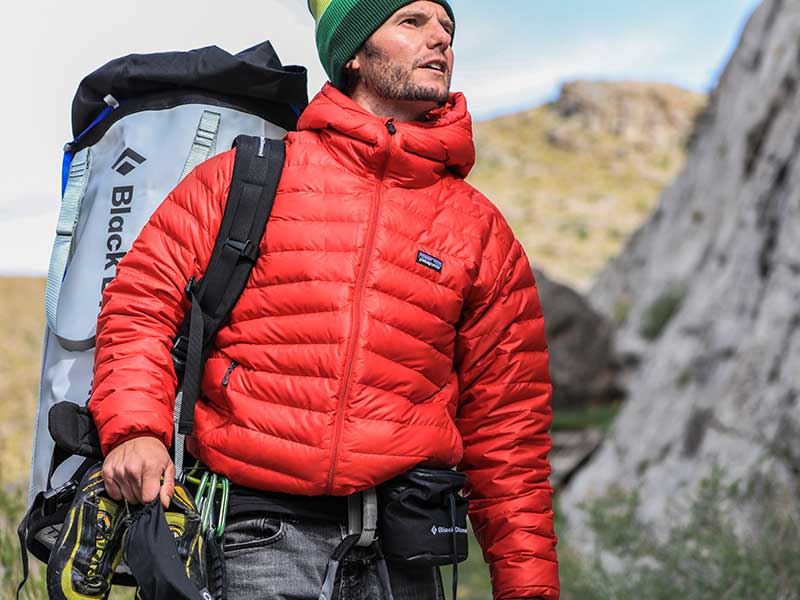Down vs Synthetic: how to choose the best insulation for your trekking
🎥 If the video has given you something, I'll be waiting for you on the channel 🙂 Subscribe
Remember that panic when you see the first drop fall on your down jacket? For years, we lived by the mantra: "down + water = total collapse". But something has changed, the quiet revolution of technical down is rewriting the rules of outdoor insulation.
What happens when the down gets wet?
For decades, down has been the star material for trekking and mountaineering jackets and sleeping bags. Its lightness, compressibility and thermal insulation have made it a favourite choice for mountaineers. However, its major weakness is well known: when it gets wet, it can lose up to 90% of its insulating capacity due to the collapse of its structure.
To understand this visually, imagine pouring water on your down jacket. The fibres clump together and form clumps that do not trap air, thus losing their ability to hold heat. This is what we call "collapsing".
The reality is that you have to make a big mistake for it to collapse completely. On treks in persistent rain, even a 650 FP down treated with DWR (Durable Water Repellent) maintains 70% of its volume after 8 hours of humidity. The reality is that the real enemy is not direct water, but rather accumulated moisture on long expeditions where it can lose up to 15% per day of insulating power.
Evolution: Hybrid down (where feather meets polyester)
The key breakthrough is in strategic mixes:
- Synthetic "anti-collapse" fibres: Tiny polyester spheres (such as PrimaLoft Cross Core) act as microscopic scaffolding.
- Water-repellent nanotechnologyNanoparticle treatments create a molecular barrier in the plume.
Faced with this historical weakness, the industry has evolved towards hybrid solutions. Garments are now produced that blend natural down with synthetic fibres, which drastically reduces the possibility of collapse.
Today, thanks to hybrid blends, it is possible to wear garments and jackets that incorporate just 10% of synthetic fibre, enough to prevent total collapse and ensure that the garment dries relatively quickly in moderate humidity.
This small percentage of synthetic fibres act as "skeletons" that prevent the down from clumping completely, allowing it to retain up to 60% of its insulating capacity, even when wet.
Is waterproofing in down jackets really effective?
Down jackets are also developed with advanced water-repellent treatments that can withstand heavy rain for extended periods of time without getting soaked. A DWR treatment (Durable Water Repellent) can typically withstand moderate rainfall for up to 60 minutes without compromising insulation too much. However, you should not consider these jackets waterproof in use. They are water repellent, but with prolonged exposure or accidental submersion, their performance can drop significantly.
I have personally tested jackets with these technologies, and while the performance is amazing during short storms, you should never do without a waterproof outer layer such as a good rain jacket to adequately protect your insulation.
Down vs synthetic fibre: which one to choose?
Here comes the key question: which is better, down or synthetic?
- Down: Superior lightness, compressibility and insulation in dry conditions. Ideal for trekking in cold and dry conditions. The quality of down is measured in fill power, typically between 650 and 850. The higher the number, the better the insulation.
- Synthetic: It retains insulating properties even when wet, dries quickly, but is somewhat heavier and bulkier.
Specific case of ultralight routes or fastpacking where you are looking to minimise weight and maximise safety in the face of rapid weather changes, hybrid garments or even a synthetic fleece may be an optimal solution.
When to choose down (and when not to)
Let's move on to concrete cases:
- For sleeping bags and static layers: Technical down wins.
- For middle layers in high activityExperts recommend pure synthetic (such as Polartec Alpha Direct) if you will be sweating heavily.
- In extremely humid environments: Opt for high-compression synthetics such as Thermoball which weighs the same as 700FP down but insulates a 40% better when wet.
Practical down care tips
To get the most out of your down equipment, follow these recommendations:
- Protection: Always wear a waterproof outer layer when it rains.
- Drying: If the down gets wet, try to dry it as soon as possible in the sun or using body heat.
- Storage: Always store down clothing in waterproof covers in your rucksack.
- Washing: Use specific products for down and tumble dry with special dryer balls to restore its original volume.
Don't miss any adventure in the Pyrenees!




